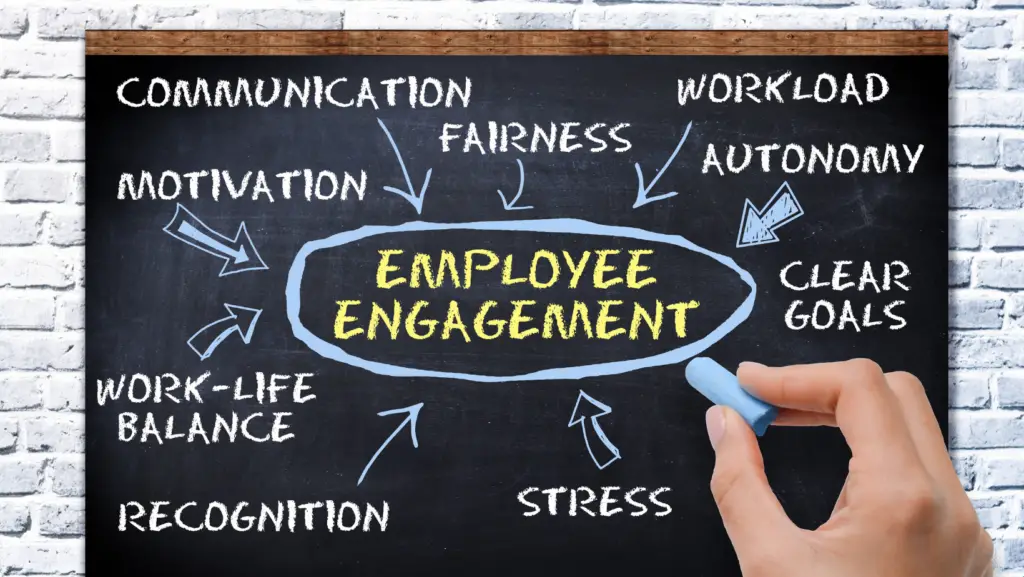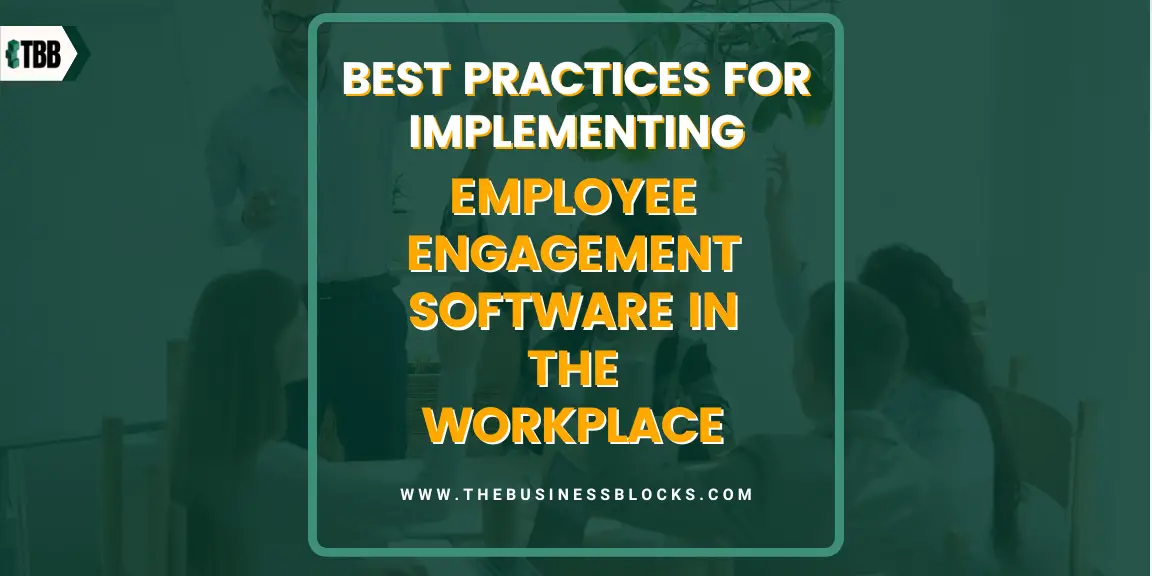Employee engagement software and tools are changing how organizations communicate and collaborate with their most valuable asset – their workforce. In this guide, we’ll look at the best practices for employee engagement software in the workplace.
Before we get there, let’s start by understanding employee engagement software and how it works.
Did you know?
- Companies with a highly engaged workforce are 21% more profitable and 17% more productive than those with disengaged staff
- In a long-term study conducted over 11 years, companies with thriving corporate cultures grew 682% in revenue, while those that lacked good company culture grew only 166% in revenue.
Are you looking to find ways to Engage Your Employees?
Employee Engagement Software can be an incredibly powerful tool for businesses. It provides the tools and resources necessary to build a highly engaged and motivated workforce, regardless of your organization’s size or size. With employee engagement software, you can track performance metrics, foster better team communication, provide employee recognition software, create meaningful surveys, and more.
Not only will implementing this type of software help increase productivity across all departments in your business, but it can also help improve morale and boost retention rates. Plus, with features like Gamification – which introduces friendly competition among team members – there are endless opportunities for fun while improving engagement.
What is Employee Engagement Software?
This 10-employee engagement software is a digital tool or platform designed to measure, analyze, and improve employee engagement within an organization. It provides various features and functionalities that enable companies to assess and enhance employee satisfaction, motivation, and commitment to their work.
Employee engagement refers to employees’ emotional connection, commitment, and motivation toward their work and the organization. Engaged employees are more likely to be passionate, productive, and loyal, leading to higher performance and better business outcomes.
Employee engagement software provides various features and functionalities to measure and improve employee engagement.
Benefits of Implementing Employee Engagement Software in the Workplace
Let’s have a quick look at the key benefits of using employee engagement software in any workplace:
Enhanced Employee Satisfaction:
It improves employee satisfaction by addressing concerns and improving the work environment.
Increased Productivity: Engaged employees are more motivated, focused, and committed, leading to higher productivity.
Improved Retention and Reduced Turnover: Engaged employees are less likely to leave, reducing turnover and associated costs.
Enhanced Communication and Collaboration: Software facilitates better interaction, promoting transparency, teamwork, and innovation.
Better Employee Development: Software identifies skill gaps and offers personalized development recommendations.
Increased Employee Recognition: Software includes features for recognizing and rewarding employee achievements.
Data-Driven Decision Making: Software provides valuable insights for informed decision-making and targeted strategies.
Best Practices to Consider When Implementing Employee Engagement Software

When a technique demonstrates efficacy and benefits enterprises, it is regarded as one of the ‘best practices’ for deploying employee engagement software. Employee engagement and satisfaction are prioritized in these strategies, which leads to increased productivity, retention, and overall organizational success.
1. Understand the importance of employee engagement software in the workplace
Recognize the significance of employee engagement software in improving workplace dynamics and employee satisfaction. Understand how it can positively impact productivity, retention, and overall organizational success.
2. Research and select the best software for your organization
Conduct thorough research to identify and select the best employee engagement software that aligns with your organization’s needs and goals. Consider features, user-friendliness, integration capabilities, and vendor reputation.
3. Set clear expectations with employees regarding using the employee engagement software
Communicate the expectations and benefits of using it to your employees. It can enhance their work experience and provide feedback, recognition, and professional growth opportunities.
4. Create a process to onboard new employees onto the platform
Establish a well-defined onboarding process for new employees to ensure they can use the software effectively. Provide training and resources to familiarize them with the platform’s features and encourage active participation.
5. Incorporate incentive structures to reward employees for using the platform
Introduce the software’s incentive structures or gamification elements to motivate employees to engage with the platform actively. Consider rewards, recognition, or competitions encouraging regular use and meaningful interactions.
6. Schedule regular check-ins with employees to ensure they’re making use of all features of the software
Schedule regular check-ins with employees to gauge their experience with the software and address any concerns or challenges they may face. Use these opportunities to provide guidance and support and encourage employees to explore and utilize all software features for their benefit.
Importance of Sustaining Employee Engagement Software in the Workplace
Maintaining employee engagement software is critical for continuing organizational progress. It gives useful information about employee attitudes, preferences, and areas for development. Consistent use assists in meeting needs, improving the work environment, and promoting development.
It also encourages long-term employee engagement by rewarding comments and contributions. This fosters a collaborative culture, enhancing productivity and retention rates. The program improves communication and transparency by providing successful collaboration and knowledge exchange tools.
Continuous usage allows for data-driven decision-making by offering insights into engagement levels, trends, and areas for improvement. This allows for more informed judgments and the implementation of focused tactics. It also assists firms in adapting to changing demands, identifying trends, and maintaining an engaging work environment.
Lastly, it positively impacts employee retention and satisfaction by demonstrating a commitment to their well-being, growth, and development.
Employee Engagement Strategies Using Employee Engagement Software

Once you understand what employee engagement software is and how it works, the next step is identifying the best strategies for leveraging it in your workplace. Here are a few of the top and most effective employee engagement strategies for using this type of software:
Encourage Open Communication
It should be used to encourage open communication among colleagues. Employees can quickly share ideas and feedback by providing easy-to-use communication tools like team chat or discussion boards.
Streamline Collaboration
It can help streamline collaboration between teams by providing a central platform for project management. This allows teams to easily track progress, assign tasks, and stay current on deadlines.
Send Regular Surveys
Surveys are an important part of employee engagement. A regular employee engagement survey can help you gain valuable insights into your workforce’s health and happiness. It makes creating customized surveys for you and your team easy. Team members and employee feedback can be collected in minutes.
Offer Employee Recognition
In addition to using employee engagement software for communication and collaboration, you should also use it to recognize employees for their hard work. You can reward staff members for outstanding performance and dedication by creating employee recognition programs. Employee recognition programs can significantly boost job satisfaction and employee engagement levels.
Gamification
Introducing a gamification workplace is one of the best ways to increase employee engagement and motivation. With features like leaderboards, point systems, and rewards, you can create an environment that encourages friendly competition while boosting morale and improving employee engagement and performance.
An effective employee engagement strategy varies from one organization to another. However, the key is to create a positive and supportive workplace culture that celebrates success and encourages employees to do their best. With the right combination of employee engagement software, custom surveys, recognition programs, and gamification strategies, you can create an environment that fosters deep engagement among your team.
How Do You Measure Employee Engagement Success?
An employee engagement strategy is great, but how do you measure success? Employee engagement software provides valuable data and analytics that allow organizations to track progress and adjust as needed.
There are signs of a Successful Employee Engagement Strategy and ways to measure them, such as:
Improved Retention
A successful employee engagement strategy can improve retention rates and lower turnover. Engage employees and actively seek out their feedback. Employee engagement software can be used to track employee satisfaction levels and identify potential areas of improvement.
Increased Productivity
Employees engaged in their work tend to be more productive overall. This could mean fewer errors, improved customer service, or increased employee output. Track key performance metrics to see if productivity is increasing over time.
Innovation and Creativity
Engaged employees are more likely to develop creative solutions and innovative ideas for the business. Encourage open communication and collaboration, so all team members can contribute their ideas and insights. With employee engagement software, you can create a platform for idea collection and feedback to boost engagement further.
Higher Morale
Engaged employees typically have higher job satisfaction and better morale. Employees who feel valued, respected, and appreciated are likelier to be engaged in their work. Use surveys to identify areas where morale might need improvement or additional recognition programs for employees who go above and beyond.
Measuring successful employee engagement strategies and tracking progress over time is essential for getting the most out of your team. Employee engagement software can track key metrics such as job satisfaction, morale, and productivity. This will help you identify areas where employees need more support and what strategies are working well.
Possible Challenges When Implementing Employee Engagement Software

Like any technology, employee engagement software is also prone to challenges and drawbacks. Here are the most common challenges in implementing employee engagement software:
Resistance to Change: Employees may resist new technology or processes, fearing the unknown, increased workload, or questioning software benefits.
Lack of User Adoption: Insufficient training, unclear communication, and perceived irrelevance can hinder employees from embracing and using the software effectively.
Integration Issues: Complexity arises when integrating employee engagement software with existing systems, causing disruptions and user frustrations.
Data Privacy and Security: Protecting sensitive employee data is crucial. They are complying with regulations and preventing unauthorized access or breaches.
Limited IT Support: Organizations lacking IT resources face challenges implementing and maintaining the software, requiring dedicated support for technical issues and updates.
ROI Measurement: Measuring the impact of employee engagement software on engagement, productivity, and outcomes poses challenges without proper evaluation methods.
Cultural and Organizational Alignment: Successful software implementation relies on aligning with the organization’s culture, values, and goals, as misalignment may lead to resistance or ineffectiveness.
Tips for Troubleshooting Common Issues with Employee Engagement Software
Here’s a list of all essential tips for troubleshooting common issues with employee engagement software:
Provide clear training: Ensure employees receive comprehensive training on using the software, explaining its features and benefits, and offering ongoing support.
Improve communication: Communicate the purpose and benefits of the software to employees through various channels, reminding them of its value.
Address user feedback: Actively listen to feedback, making software improvements based on employee input to increase adoption and trust.
Offer troubleshooting resources: Develop a comprehensive guide with step-by-step instructions and FAQs for employees to resolve minor issues independently.
Provide dedicated support: Assign IT personnel to assist with technical problems, minimizing disruptions promptly.
Conduct regular updates: Keep the software up to date, address bugs and vulnerabilities, and inform employees about maintenance activities.
Encourage learning and collaboration: Foster a culture of sharing experiences and insights, enabling peer support through forums or internal communities.
Monitor user engagement: Track metrics to identify issues, analyze data and feedback, and proactively address recurring problems.
Seek vendor support: Reach out to the software vendor for assistance with complex issues or customized solutions.
Regularly evaluate effectiveness: Continuously assess the software’s impact through feedback, surveys, and metrics, making informed decisions for improvement or alternative solutions.
Frequently Asked Questions About Employee Engagement Software
Q: What is employee engagement software, and why is it important?
A: Employee engagement software is a digital platform that measures and enhances employee engagement. It is essential as it creates a positive work environment, boosts morale, increases productivity, and reduces turnover.
Q: How can employee engagement software benefit my organization?
A: Employee engagement software improves communication, enhances satisfaction and retention, boosts productivity, supports development, enables data-driven decisions, and fosters connection within the workforce.
Q: How can I ensure the successful implementation and adoption of employee engagement software?
A: Communicate purpose and benefits, provide training and support, secure leadership buy-in, choose user-friendly software, involve employees, and continuously improve the software based on feedback.
Q: How effective employee engagement strategies can be implemented?
A: Employee engagement strategies should be tailored to each organization’s needs. The most effective strategies involve creating a positive workplace culture that encourages open communication, collaboration, and employee appreciation.
Conclusion
Implementing effective employee engagement software in your workplace can tremendously impact job satisfaction and productivity. It is ideal for any organization that relies heavily on timely performance reviews or wants to search for new talents actively. Employers can benefit from better communication, greater team collaboration, and more innovative analytics with the right software. A few strategies should be used to ensure success in employee engagement initiatives and maximize return on investment. With these best practices in mind, organizations will experience positive outcomes when investing in employee engagement software.
We hope this guide answers your questions and encourages you to think deeply about employee engagement tools and their benefits for businesses and organizations.

